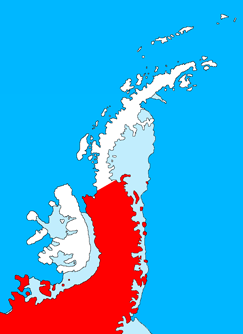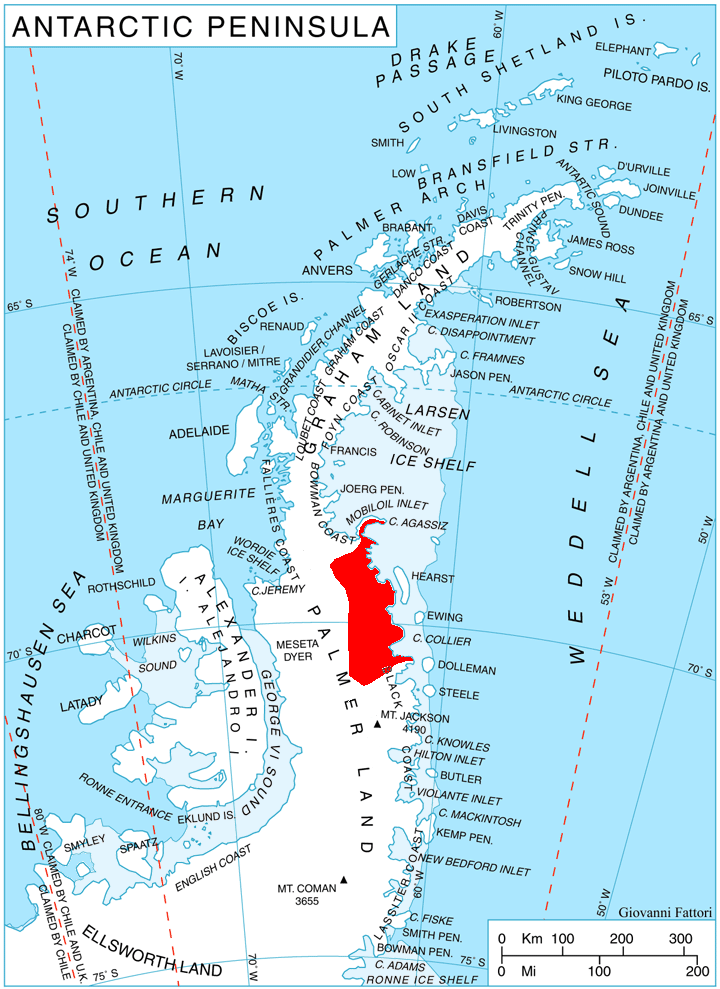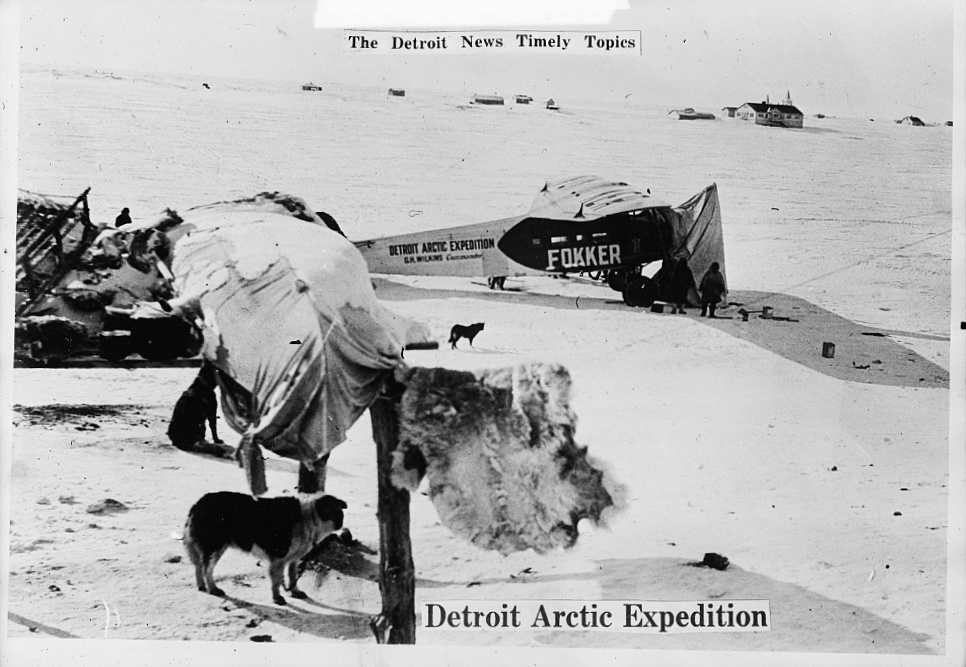|
Elder Bluff
Eielson Peninsula () is a rugged, mainly snow-covered peninsula, long in an east–west direction and averaging wide, lying between Smith Inlet and Lehrke Inlet on the east coast of Palmer Land, Antarctica. Location The Kvinge Peninsula is on the Wilkins Coast of Palmer Land, beside the Weddell Sea to the east. It lies between Yates Glacier and Lehrke Inlet to the south and Smith Inlet to the north. Dolleman Island is to the east. The Welch Mountains are west-southwest, the Eland Mountains are west and the Columbia Mountains are northwest. Features include Cape Boggs at the eastern end, Elder Bluff, Houston Glacier, Gurling Glacier, Leininger Peak, Mount Thompson, Ashton Glacier and Dawson Head. Discovery and name The rocky north wall of the Eielson Peninsula is probably the feature which, on his flight of December 20, 1928, Sir Hubert Wilkins sighted and named "Cape Eielson" from a position above Stefansson Strait (Wilkins gave the name to the farthest south ro ... [...More Info...] [...Related Items...] OR: [Wikipedia] [Google] [Baidu] |
Palmer Land
Palmer Land () is the portion of the Antarctic Peninsula, Antarctica that lies south of a line joining Cape Jeremy and Cape Agassiz. This application of Palmer Land is consistent with the 1964 agreement between the Advisory Committee on Antarctic Names and the UK Antarctic Place-Names Committee, in which the name Antarctic Peninsula was approved for the major peninsula of Antarctica, and the names Graham Land and Palmer Land for the northern and southern portions, respectively. The line dividing them is roughly 69° S. Boundaries In its southern extreme, the Antarctic Peninsula stretches west, with Palmer Land eventually bordering Ellsworth Land along the 80° W line of longitude. Palmer Land is bounded in the south by the ice-covered Carlson Inlet, an arm of the Filchner–Ronne Ice Shelf, Filchner-Ronne Ice Shelf, which crosses the 80° W line. This is the base of Cetus Hill. This feature is named after Nathaniel Palmer, an American sealer who explored the Antarctic Peninsula a ... [...More Info...] [...Related Items...] OR: [Wikipedia] [Google] [Baidu] |
Dawson Head
Lehrke Inlet () is an ice-filled inlet, wide, which recedes southwest for between Cape Boggs and Cape Sharbonneau, along the east coast of Palmer Land, Antarctica. Location The Lehrke Inlet of the Weddell Sea is on the east coast of Palmer Land, at the north end of the Black Coast of the Antarctic Peninsula. It is south of the Eielson Peninsula and Dolleman Island, and north of the Imshaug Peninsula and Steele Island. The Eland Mountains are to the northwest and the Welch Mountains are to the west-southwest. Glaciers feeding the inlet include, clockwise from the south, Gain Glacier, Dana Glacier, Yates Glacier, Matheson Glacier and Ashton Glacier. Other features include Cape Boggs, Cape Sharbonneau, Mount Hill on the Imshaus Peninsula, Neilson Peak on the Parmalee Massif, and Dawson Head. Discovery and name Lehrke Inlet was discovered by members of the United States Antarctic Service (USAS) who explored this coast on land and from the air in 1940. It was named for Lester ... [...More Info...] [...Related Items...] OR: [Wikipedia] [Google] [Baidu] |
Ronne Antarctic Research Expedition
The Ronne Antarctic Research Expedition (RARE) was an expedition from 1947–1948 which researched the area surrounding the head of the Weddell Sea in Antarctica. Background Finn Ronne led the RARE which was the final privately sponsored expedition from the United States and explored and mapped the last unknown coastline on earth and determined that the Weddell Sea and the Ross Sea were not connected. The expedition included Isaac Schlossbach, as second in command, who was to have Cape Schlossbach named after him. The expedition, based out of Stonington Island was the first to take women to over-winter. Ronne's wife, Edith Ronne was correspondent for the North American Newspaper Alliance for expedition and the chief pilot Darlington took his wife. Partial listing of discoveries * Mount Abrams – Named for Talbert Abrams, noted photogrammetric engineer * Mount Becker – Named for Ralph A. Becker, legal counsel who assisted in the formation of RARE * Mount Brun ... [...More Info...] [...Related Items...] OR: [Wikipedia] [Google] [Baidu] |
British Antarctic Survey
The British Antarctic Survey (BAS) is the United Kingdom's national polar research institute. It has a dual purpose, to conduct polar science, enabling better understanding of list of global issues, global issues, and to provide an active presence in the Antarctic on behalf of the UK. It is part of the Natural Environment Research Council (NERC). With over 400 staff, BAS takes an active role in Antarctic affairs, operating five research stations, one ship and five aircraft in both polar regions, as well as addressing key global and regional issues. This involves joint research projects with over 40 UK universities and more than 120 national and international collaborations. Having taken shape from activities during World War II, it was known as the Falkland Islands Dependencies Survey until 1962. History Operation Tabarin was a small British expedition in 1943 to establish permanently occupied bases in the Antarctic. It was a joint undertaking by the British Admiralty, Admiralt ... [...More Info...] [...Related Items...] OR: [Wikipedia] [Google] [Baidu] |
UK Antarctic Place-Names Committee
The UK Antarctic Place-Names Committee (or UK-APC) is a United Kingdom government committee, part of the Foreign and Commonwealth Office, responsible for recommending names of geographical locations within the British Antarctic Territory (BAT) and the South Georgia and the South Sandwich Islands (SGSSI). Such names are formally approved by the Commissioners of the BAT and SGSSI respectively and published in the BAT Gazetteer and the SGSSI Gazetteer maintained by the Committee. The BAT names are also published in the international Composite Gazetteer of Antarctica maintained by SCAR. The Committee may also consider proposals for new place names for geographical features in areas of Antarctica outside BAT and SGSSI, which are referred to other Antarctic place-naming authorities or decided by the Committee itself if situated in the unclaimed sector of Antarctica. Names attributed by the committee * Anvil Crag, named for descriptive features * Anckorn Nunataks, named after J. F ... [...More Info...] [...Related Items...] OR: [Wikipedia] [Google] [Baidu] |
United States Antarctic Research Program
The United States Antarctic Program (or USAP; formerly known as the United States Antarctic Research Program or USARP and the United States Antarctic Service or USAS) is an organization of the United States government which has a presence in the Antarctica continent. Founded in 1959, the USAP manages all U.S. scientific research and related logistics in Antarctica as well as aboard ships in the Southern Ocean. United States Antarctic Program The United States established the U.S. Antarctic Research Program (USARP) in 1959—the name was later changed to the U.S. Antarctic Program—immediately following the success of the International Geophysical Year (IGY). Today, the National Science Foundation (NSF) has a Presidential Mandate to manage the United States Antarctic Program, through which it operates three year-round research stations and two research vessels, coordinates all U.S. science on the southernmost continent, and works with other federal agencies, the U.S. militar ... [...More Info...] [...Related Items...] OR: [Wikipedia] [Google] [Baidu] |
United States Geological Survey
The United States Geological Survey (USGS), founded as the Geological Survey, is an agency of the U.S. Department of the Interior whose work spans the disciplines of biology, geography, geology, and hydrology. The agency was founded on March 3, 1879, to study the landscape of the United States, its natural resources, and the natural hazards that threaten it. The agency also makes maps of planets and moons, based on data from U.S. space probes. The sole scientific agency of the U.S. Department of the Interior, USGS is a fact-finding research organization with no regulatory responsibility. It is headquartered in Reston, Virginia, with major offices near Lakewood, Colorado; at the Denver Federal Center; and in NASA Research Park in California. In 2009, it employed about 8,670 people. The current motto of the USGS, in use since August 1997, is "science for a changing world". The agency's previous slogan, adopted on its hundredth anniversary, was "Earth Science in the Pub ... [...More Info...] [...Related Items...] OR: [Wikipedia] [Google] [Baidu] |
Advisory Committee On Antarctic Names
The Advisory Committee on Antarctic Names (ACAN or US-ACAN) is an advisory committee of the United States Board on Geographic Names responsible for recommending commemorative names for features in Antarctica. History The committee was established in 1943 as the Special Committee on Antarctic Names (SCAN). It became the Advisory Committee on Antarctic Names in 1947. Fred G. Alberts was Secretary of the Committee from 1949 to 1980. By 1959, a structured nomenclature was reached, allowing for further exploration, structured mapping of the region and a unique naming system. A 1990 ACAN gazeeter of Antarctica listed 16,000 names. Description The United States does not recognise territorial boundaries within Antarctica, so ACAN assigns names to features anywhere within the continent, in consultation with other national nomenclature bodies where appropriate, as defined by the Antarctic Treaty System. The research and staff support for the ACAN is provided by the United States Geologi ... [...More Info...] [...Related Items...] OR: [Wikipedia] [Google] [Baidu] |
Carl B
Carl may refer to: *Carl, Georgia, city in USA *Carl, West Virginia, an unincorporated community *Carl (name), includes info about the name, variations of the name, and a list of people with the name *Carl², a TV series * "Carl", an episode of television series ''Aqua Teen Hunger Force'' * An informal nickname for a student or alum of Carleton College CARL may refer to: *Canadian Association of Research Libraries *Colorado Alliance of Research Libraries See also *Carle (other) *Charles *Carle, a surname *Karl (other) *Karle (other) Karle may refer to: Places * Karle (Svitavy District), a municipality and village in the Czech Republic * Karli, India, a town in Maharashtra, India ** Karla Caves, a complex of Buddhist cave shrines * Karle, Belgaum, a settlement in Belgaum ... {{disambig ja:カール zh:卡尔 ... [...More Info...] [...Related Items...] OR: [Wikipedia] [Google] [Baidu] |
United States Antarctic Service
The United States Antarctic Program (or USAP; formerly known as the United States Antarctic Research Program or USARP and the United States Antarctic Service or USAS) is an organization of the United States government which has a presence in the Antarctica continent. Founded in 1959, the USAP manages all U.S. Research stations in Antarctica, scientific research and related Transport in Antarctica, logistics in Antarctica as well as aboard ships in the Southern Ocean. United States Antarctic Program The United States established the U.S. Antarctic Research Program (USARP) in 1959—the name was later changed to the U.S. Antarctic Program—immediately following the success of the International Geophysical Year (IGY). Today, the National Science Foundation (NSF) has a Presidential Mandate to manage the United States Antarctic Program, through which it operates three year-round research stations and two research vessels, coordinates all U.S. science on the southernmost continent, ... [...More Info...] [...Related Items...] OR: [Wikipedia] [Google] [Baidu] |
Stefansson Strait
Stefansson Strait () is an ice-filled strait long and wide, between the east coast of Palmer Land and Hearst Island, Antarctica. Location Stefansson Strait is on the Wilkins Coast of Palmer Land, beside the Weddell Sea to the east. It is east of the Eternity Range, north of Hughes Ice Piedmont and south of Scripps Heights and Casey Inlet. The strait separates Hearst Island from the mainland. The south of the strait is at the north side of the mouth of Anthony Glacier, which flows eastward past the Engel Peaks and Mount Martin to enter the sea north of Lewis Point. Features of the coast to the west of the strait, from south to north, include Rhino Rock, Cape Rymill, Briesemeister Peak and Cape Reichelderfer. The Binghy Glacier flows east between De Busk Scarp and Le Feuvre Scarp to enter the trait north of Cape Reichelderfer. Lurabee Glacier flow northeast along the southeast side of Scripps Heights to enter the sea just north of the strait between Cape Walcott and Cape Hink ... [...More Info...] [...Related Items...] OR: [Wikipedia] [Google] [Baidu] |
Sir Hubert Wilkins
Sir George Hubert Wilkins MC & Bar (31 October 188830 November 1958), commonly referred to as Captain Wilkins, was an Australian polar explorer, ornithologist, pilot, soldier, geographer and photographer. He was awarded the Military Cross after he assumed command of a group of American soldiers who had lost their officers during the Battle of the Hindenburg Line, and became the only official Australian photographer from any war to receive a combat medal. He narrowly failed in an attempt to be the first to cross under the North Pole in a submarine, but was able to prove that submarines were capable of operating beneath the polar ice cap, thereby paving the way for future successful missions. The US Navy later took his ashes to the North Pole aboard the submarine USS ''Skate'' on 17 March 1959. Early life Hubert Wilkins was a native of Mount Bryan East, South Australia, the last of 13 children in a family of pioneer settlers and sheep farmers. He was born at Mount Bryan East ... [...More Info...] [...Related Items...] OR: [Wikipedia] [Google] [Baidu] |







